
Deritend is a historic area of Birmingham, England, built around a crossing point of the River Rea. It is first mentioned in 1276. Today Deritend is usually considered to be part of Digbeth.

Deritend is a historic area of Birmingham, England, built around a crossing point of the River Rea. It is first mentioned in 1276. Today Deritend is usually considered to be part of Digbeth.
Deritend was a crossing point of the River Rea before Birmingham was of any significance. When Peter de Bermingham obtained a charter for a market around 1156 the area to the west of the crossing, Digbeth and beyond, grew into what is now Birmingham. Deritend (in the past called Der-yat-end, possibly Deer Gate End) was across the river towards Warwick in the parish of Aston.
Deritend is first mentioned in 1276 when it is reported that an area on the road in the town of Birmingham encroached into an area of land in the parish of Aston. The first mention of Deritend by name is by Sir John de Birmyneham in 1381, who refers to it as 'Duryzatehende'. A further variation occurs in 1430, in a legal record, written in Latin, where it appears as "Durghzatende iuxta Brymyngeham". The letter after the "gh" does not exist in modern English, & differs from the preceding "g". [1]
The Old Crown pub in Deritend High Street is claimed to be the oldest extant secular building in Birmingham. It is Grade II* listed, and claims to date back to circa 1368, retaining its "black and white" timber frame, although almost all of the present building dates from the early 16th century. [2]
There are a number of notable buildings in Deritend including:
Construction work in the area in 1953 uncovered pottery dating to the medieval period. These are now on display in the Birmingham Museum & Art Gallery.

The River Rea is a small river which passes through Birmingham, England. It is the river on which Birmingham was founded by the Beorma tribe in the 7th century.

The Custard Factory is a creative and digital business workspace complex, including independent shops, cafes and bars, on the site of what was the Bird's Custard factory off High Street, Deritend, in the Digbeth area of central Birmingham, England.

Yardley is an area in east Birmingham, England. It is also a council constituency, managed by its own district committee. Historically it lay within Worcestershire.
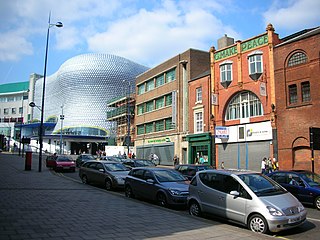
Digbeth is an area of central Birmingham, England. Following the destruction of the Inner Ring Road, Digbeth is now considered a district within Birmingham City Centre. As part of the Big City Plan, Digbeth is undergoing a large redevelopment scheme that will regenerate the old industrial buildings into apartments, retail premises, offices and arts facilities. The district is considered to be Birmingham's 'Creative Quarter'.
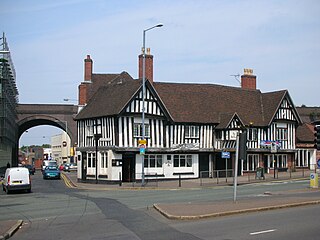
The Old Crown, a pub in Deritend, claims to be one of the oldest extant secular buildings in Birmingham, England. It is Grade II* listed, and claims to date back to c. 1368, retaining its "black and white" timber frame, although almost all of the present building dates from the early 16th century.
Witton is an inner city area in Birmingham, England, in the metropolitan county of the West Midlands. It was within the ancient parish of Aston in the Hemlingford hundred of the historic county of Warwickshire. It is known as the home of Aston Villa Football Club at Villa Park.
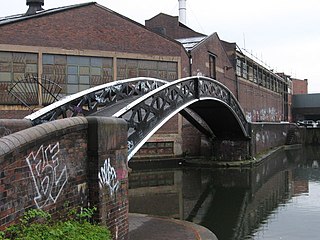
Bordesley is an area of Birmingham, England, 1.2 miles (2 km) south east of the city centre straddling the Watery Lane Middleway ring road. It should not be confused with nearby Bordesley Green. Commercial premises dominate to the west of the ring road, but much of this area is to be redeveloped. Blocks of residential apartments are planned and set for completion from the mid-2020s onwards. The largely residential area east of the ring road was renamed Bordesley Village following large scale clearance of back-to-back houses and redevelopment in the 1980s and 90s. Bordesley is the real life setting of the BBC series Peaky Blinders, and home to Birmingham City Football Club's ground, St Andrew's.

Eastside is a district of Birmingham City Centre, England that is undergoing a major redevelopment project. The overall cost when completed is expected to be £6–8 billion over ten years which will result in the creation of 12,000 jobs. 8,000 jobs are expected to be created during the construction period. It is part of the larger Big City Plan project.
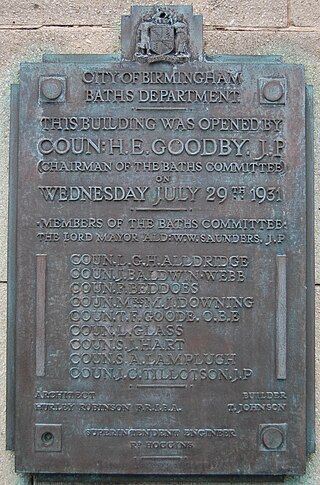
The Birmingham Baths Committee was an organisation responsible for the provision and maintenance of public swimming and bathing facilities. Birmingham City Council funded, constructed and ran bathing facilities throughout the city. The movement to develop baths and wash houses in Britain had its impetus with the rapid urbanisation of the Industrial Revolution, which was felt acutely in Birmingham, one of England's powerhouses.

The Warwick Bar conservation area is a conservation area in Birmingham, England which was home to many canalside factories during the Industrial Revolution of the eighteenth and nineteenth centuries.
Smithfield was an inner-city area of Birmingham, England, southeast of the Bull Ring markets.
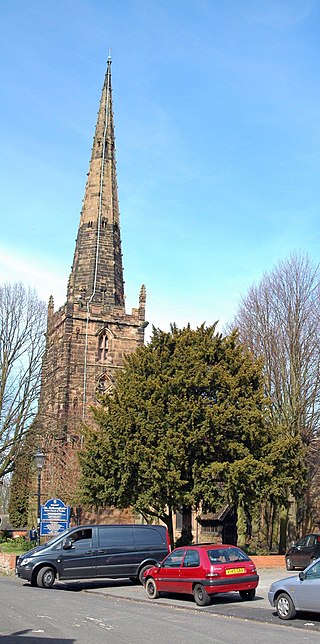
St Edburgha's Church is a parish church in the Yardley area of Birmingham, England. It is a Grade I listed building and a part of the Old Yardley conservation area.
This article is intended to show a timeline of events in the History of Birmingham, England, with a particular focus on the events, people or places that are covered in Wikipedia articles.

Birmingham city centre, also known as Central Birmingham, is the central business district of Birmingham, England. The area was historically in Warwickshire. Following the removal of the Inner Ring Road, the city centre is now defined as being the area within the Middle Ring Road. The city centre is undergoing massive redevelopment with the Big City Plan, which means there are now nine emerging districts and the city centre is approximately five times bigger.

The Lad in the Lane is a pub in the Bromford area of Erdington in Birmingham, England. Dating to the year 1400, it is considered to be the oldest house and pub in the city, although The Old Crown in Digbeth claims to date from 1368, a date which is yet to be confirmed. Prior to the dating of the building, New Shipton Barn in Walmley was considered to be the oldest building in Birmingham, dating to around 1425. To find the construction date of the building, scientists used a technique called dendrochronology to analyse the timbers in the oldest known part of the building. The results showed that it was constructed in the spring at the end of the 14th century.

Birmingham Curzon Street railway station is the planned northern terminus of High Speed 2 in the city centre of Birmingham, England. The new railway will connect Birmingham to London Euston via Birmingham Interchange and Old Oak Common. Curzon Street will have seven terminal platforms and is planned to open in 2026.
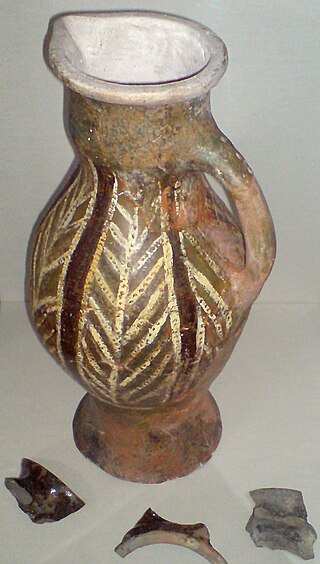
Deritend ware is a distinctive style of medieval pottery produced in Birmingham, England in the twelfth and thirteenth centuries. There are three types of Deritend ware; a fine to moderately sandy, micaceous orange to red ware, used mainly for jugs, with some examples of bowls, dripping trays and aquamaniles, dating to the 13th to early 14th centuries; a black or, less frequently, grey ware with a brown core, also micaceous, used mainly for cooking pots/jars and less commonly for large unglazed jugs and skillets/pipkins, dating from possibly the late 12th century to the early 14th century; and a sandy brown ware with grey core used for cooking pots, dating from possibly the late 12th century to 13th century. Wasters i.e. pottery misfires have been found for all three wares in Birmingham. Glazed Deritend ware jugs were decorated with white slip lines and applied white clay strips, often roller stamped, and white clay pads, The more complex decorative schemes are in the North French style ; the decorated jugs closely resemble London-type ware and it is distinctly possible that the Deritend ware industry included migrant potters from the London area in the thirteenth century.

The Guild or Gild of St John the Baptist was an English medieval religious guild in Deritend - an area of the manor of Birmingham within the parish of Aston. It maintained the priest of St John's Chapel, Deritend as its own chaplain, paying his stipend of £5 per year, and also supported a grammar school with its own schoolmaster.

St Anne's Church is a Roman Catholic Parish church on Alcester Street in Digbeth, part of the city centre of Birmingham. It was founded by Saint John Henry Newman in 1849. It was moved to a new building in 1884 designed by London architects Albert Vicars and John O'Neill, who also designed St Hugh's Church in Lincoln, and helped design St Peter's Cathedral in Belfast.
52°28′31″N1°53′02″W / 52.4753°N 1.8839°W